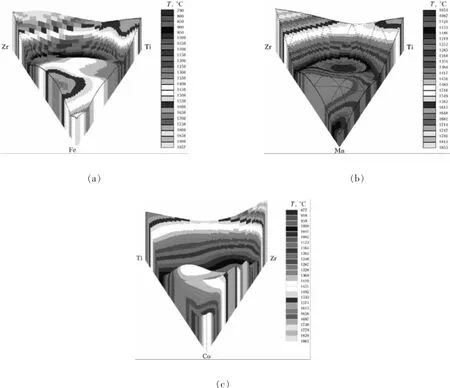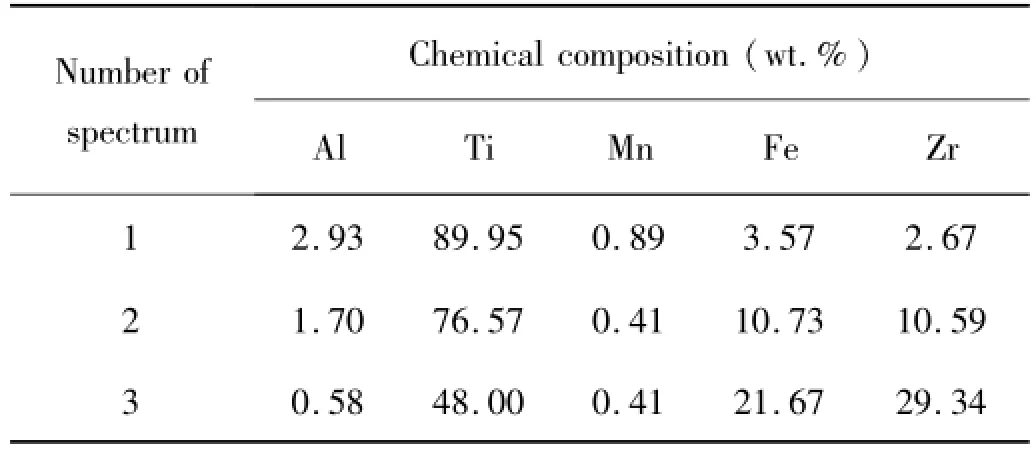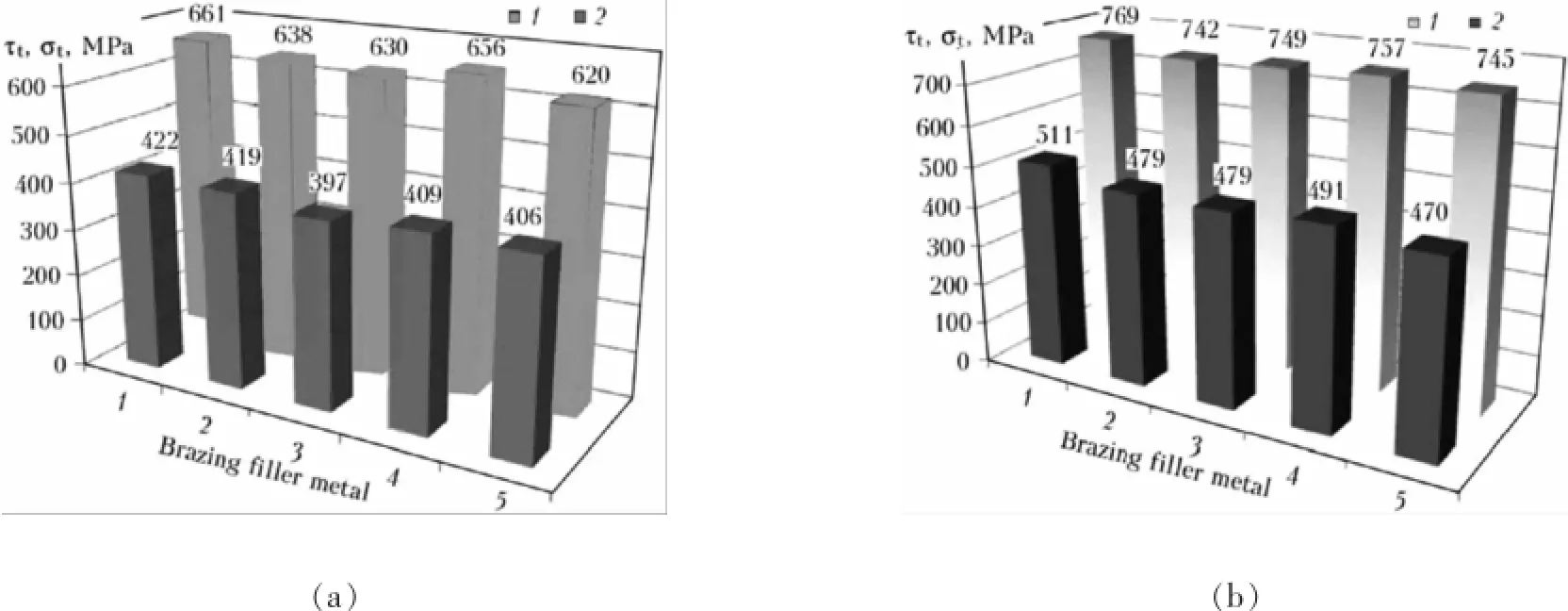New filler metal systems for the brazing of titanium alloys
V.F.Khorunov,S.V.Maksymova and V.V.Voronov*
New filler metal systems for the brazing of titanium alloys
V.F.Khorunov,S.V.Maksymova and V.V.Voronov*
It’s well known welding takes the leading role in development of titanium structures.However,in number of cases technological processes of brazing are more appropriate and,sometimes,being the single possible,in particular,during production of multilayer thin-wall structures.It should be noted that brazing filler metals of Ti-Cu-Ni,Ti-Zr-Cu-Ni,Zr-Ti-Ni and Cu-Zr-Ti systems in a form of plastic foils,as well as in powder form are mainly used in world practice for brazing of titanium alloys.Present work provides the results of complex investigations of brazing filler metals of Ti-Zr-Fe,Ti-Zr-Mn and Ti-Zr-Co systems using differential thermal analysis,light and scanning microscopy,X-ray microspectrum analysis.Data on melting ranges of pilot alloys were obtained,and liquidus surfaces of given systems using simplex-lattice method were build. Brazing filler metals covering brazing temperature range of current structural titanium materials based on solid solutions as well as intermetallics were proposed.Structure,chemical inhomogeniety and strength characteristics of brazed joints were studied.It is determined that brazing of solid solution based alloys(OT4,VT6)using indicated brazing filler metals ensures strength characteristics of joints,which are not inferior to that obtained with application of known brazing filler metals even if they are received at lower brazing temperature.
vacuum brazing,titanium alloys,inter-metallic alloys,brazing filler metals,brazed joints,structure,strength of brazed joints
0 Introduction
It’s well known welding takes the leading role in development of titanium structures.However,in number of cases technological processes of brazing are more appropriate and,sometimes,being the single possible,in particular,during production of multilayer thin-wall structures. Appearance of new intermetallics based high-strength titanium alloys also increases probability of application of brazing technology.It should be noted that brazing filler metals(BFMs)of Ti-Cu-Ni,Ti-Zr-Cu-Ni,Zr-Ti-Ni and Cu-Zr-Ti systems in a form of plastic foils,obtained by method of ultraspeed quenching or traditional methods of metallurgical redistribution with pressure treatment and vapor phase deposition,as well as in powder form[1-5]are mainly used in world practice for brazing of titanium alloys. However,development of new alloy systems is continued. It is related with the tasks of reduction of brazing temperature for wrought titanium alloys,as well as expansion of area of BFM application(for example,in medicine,in brazing of intermetallic alloys etc.).
Present work proposes the braze compositions selected on the basis of complex investigation of Ti-Zr-(Fe,Mn,Co)system alloys,which can be used for brazing of wrought and intermetallic titanium alloys providing temperature-time parameters of technological process of vacuum brazing and preserving microstructure and mechanical properties of initial material to be brazed,as well as eliminating the formation of brittle intemetallic phases in the brazing seams.
1 Experiments
Studies of Ti-Zr-Fe,Ti-Zr-Mn,Ti-Zr-Co system alloys[6-7]were carried out at the E.O.Paton Electric Welding Institute as an alternative to existing ones.Constitutional diagrams of Ti-Fe,Ti-Mn and Ti-Co systems are similar.Eutectics with high content of titanium and wide area of solid solution based on titanium and eutectoid are present in high-titanium area of these alloys.Ti-Mn system has the highest temperature of eutectic melting,Ti-Fe system displays significantly lower and Ti-Co has the smallestone(Table 1).Typical characteristics described above are preserved in the alloys of Zr-Fe,Zr-Mn and Zr-Co binary systems[9].At the same time,areas of solid solutions are narrower,and eutectoid transformation takes place at higher temperatures.Melting temperatures of eutectics follow the tendency of indicated titanium-based alloys except for Zr-Co system(see Table 1).
It can be assumed based on study of binary systems that ternary eutectics with temperature suitable for brazing of titanium wrought pseudo-a and(a+p)-alloys(not more than 935℃)and intermetallic alloys(above 1 150℃)are present in three-component systems.It was necessary to build liquidus surfaces of these three-component systems in order to verify this hypothesis.

Table 1 Temperature of eutectic melting and eutectoid transformation of alloys of the various systems[8]
Combination of calculation and experimental methods,in particular,method of simplex-lattice planning of experiment[9-10],was used for realization of this task. This method is developed for reduction of number of physical experiments,decrease of time consumption as well as costs.Field of application of present method is sufficiently wide and can be used for building of composition-property diagrams,liquidus surfaces and surfaces of phase transformations in multi-component systems etc.
From 33 to 57 alloys of each system were manufactured and their melting ranges were determined for obtaining of necessary calculation data.
2 Results and discussion
Analysis of obtained results shows that specific part of each from the three alloy systems,containing monovariant eutectics with decreased melting temperature,is the most suitable for application as BFMs in brazing of titanium and its alloys.As expected alloys of Ti-Zr-Mn system were the most refractory and Ti-Zr-Co system had the lowest melting temperature(Fig.1).
One BFM from each system was selected for investigation of their technological properties and strength of brazed joints in order to compare with known BFMs.BFMs of Ti-Zr-Fe and Ti-Zr-Co systems were used for brazing of structural titanium alloys(together with industrial BFM of Ti-Zr-Cu-Ni system).
Brazing of specimens was performed in vacuum(7× 10-3Pa)with the help of radiation heating.Two brazing temperatures,920 and 990℃,and two BFMs of Ti-Zr-Co and Ti-Zr-Fe systems,were used for wrought titanium alloys OT4(Ti-4Al-1Mn)and VT6(Ti-6Al-4V)respectively,and brazing time was fixed at 15 min.Results of performed experiments determined that BFMs in cast form spread well over the surface of titanium alloys and form smooth full fillets.
Metallographic investigations of the brazed specimens verify that external welds,which were brazed using selected industrial and experimental BFMs,have no significant differences.Seam in some distance from the fillet represents itself common intergrown grains of the base metal. Sometimes these areas are impossible to be distinguished from the base metal and joint zone can be determined only through investigation of chemical inhomogeniety(Fig.2).

Fig.1 Liquidus surface of alloys of Ti-Zr-Fe(a),Ti-Zr-Mn(b)and Ti-Zr-Co(c)systems

Fig.2 Microstructure of central area of seam(a)of brazed joint(OT4 base metal,Ti-Zr-Co BFM,light microscope,×500),and near-fillet areas(b)of X-ray microspectrum analysis of brazed joint(OT4 base metal,Ti-Zr-Fe BFM)
The data of X-ray microspectrum analysis show that base metal adjacent to the fillet has doublephase structure(Fig.2b),its chemical composition is close to initial composition of OT4 alloy and includes insignificant quantity of chemical elements of the BFM(Table 2,spectrum 1).Significant reduction of content of titanium,aluminum,manganese and substantial increase of iron and zirconium are observed in the interface(see Table 2,spectrum 2).This tendency is less apparent in the fillet area(Table 2,spectrum 3.It can be concluded considering mentioned above that 15 min holding is enough for formation in the seam of alloy close to metal being brazed duringbrazing using both BFMs.At that eutectic structure is preserved in the fillet.

Table 2 Chemical composition of brazed joint(OT4 base metal,Ti-Zr-Fe BFM)
Series of butt and lap specimens from titanium alloys OT4 and VT6 was manufactured using standard and investigated BFMs(Table 3)in order to get an idea about strength characteristics of brazed titanium alloys.Fig.3a and Fig.3b show the results of tests(average of three measurements).
Analysis of results of mechanical test showed that proposed alloy systems provide for mechanical properties of the brazed joints at the level of that obtained during brazing using known BFM of Ti-Zr-Cu-Ni system.This is achieved at significantly lower brazing temperature applying BFM of Ti-Zr-Co system.

Table 3 BFMs and brazing modes of wrought titanium alloys OT4 and VT6

Fig.3 Tensile strength of brazed butt at(1)and lap(2)specimens base metal OT4(a)and base metal VT6(b)obtained using BFMs on the basis of systems:1-Ti-Zr-Co;2-Ti-Zr-Cu-Ni;3-Ti-Zr-Cu-Ni;4-Ti-Zr-Fe;5-Ti-Zr-Fe
3 Conclusions
(1)Brazing filler metals for brazing of structural titanium alloys were proposed based on the results of complex investigations of Ti-Zr-Co and Ti-Zr-Fe system alloys. They provide good wetting and spread over these materials at brazing temperature 900 and 920℃,respectively,and form structurally uniform brazed seams even during small soaking(15 minutes)at brazing temperature.
(2)It was determined,based on the results of testing of OT-4(Ti-4Al-1Mn)and VT-6(Ti-6Al-4V)alloy butt and lap joints,brazed in vacuum using developed brazing filler materials(Ti-Zr-Fe and Ti-Zr-Co system),that they provide strength characteristics making 75%-80%of base material strength.
[1] Shapiro A E,Rabinkin A.State of the art and new potential aerospace applications of titanium-based brazing filler metals:overview.Welding J,2003,82(10):36-43.
[2] VIAM.Aircraft materials.Braze filler metals.http://viam. ru/index.php&id_page=51.
[3] Matsu K.Titanium brazing for manufacturing titanium heat exchangers.In:Proc.of 3rd Int.Brazing and Soldering Conf.(April 24-26,2006,San Antonio,USA).Materials Park:ASM Int.,2006:307-309.
[4] Handbook on brazing.Ed.by I.E.Petrunin.Moscow:Mashinostroenie,2003.
[5] Schwartz M M.Brazing.Materials Park:ASM Int.,1987.
[6] Khorunov V F,Maksymova S V,Zelinskaya G M.Investigation of structure and phase composition of alloys based on the Ti-Zr-Fe system.The Paton Welding J,2010(9):9-14.
[7] Khorunov V F,Maksymova S V,Voronov V V.Investigation of alloys of Ti-Zr-Co system and their use as the brazing filler metals.Svarochn Proizvodstvo,2013(2):29-33.
[8] Binary alloy phase diagrams.Ed.by T.B.Massalski.Materials Park:ASM Int.,1990.
[9] Zedgenidze I G.Planning of experiment for study of multicomponent systems.Moscow:Nauka,1976.
[10] Scheffe H.Experiments with mictures.J.Roy.Statist. Soc.,B,1958,20(2):334.
*V.F.Khorunov,S.V.Maksymova and V.V.Voronov,E.O.Paton Electric Welding Institute,NASU 11 Bozhenko Str.,03680,Kiev,Ukraine,E-mail:office@paton.kiev.ua
- China Welding的其它文章
- Effect of gallium addition on microstructure and properties of Ag-Cu-Zn-Sn alloys*
- Influence of Mn on wettability and microstructure of low-silver lead-free solders*
- Plastic characterization and performance of SnAgCuBiNi/Cu lead-free BGA solder joints*
- Macrostructures and mechanical properties of ultrasonic-assisted friction stir welding joint of 2024-T3 aluminium alloy
- Influences of acoustic field parameters on welding arc behavior in ultrasonic-MIG welding*
- Microstructure evolution in the weld metal region of a Ni-based Inconel 718 superalloy produced by tungsten inert gas welding

